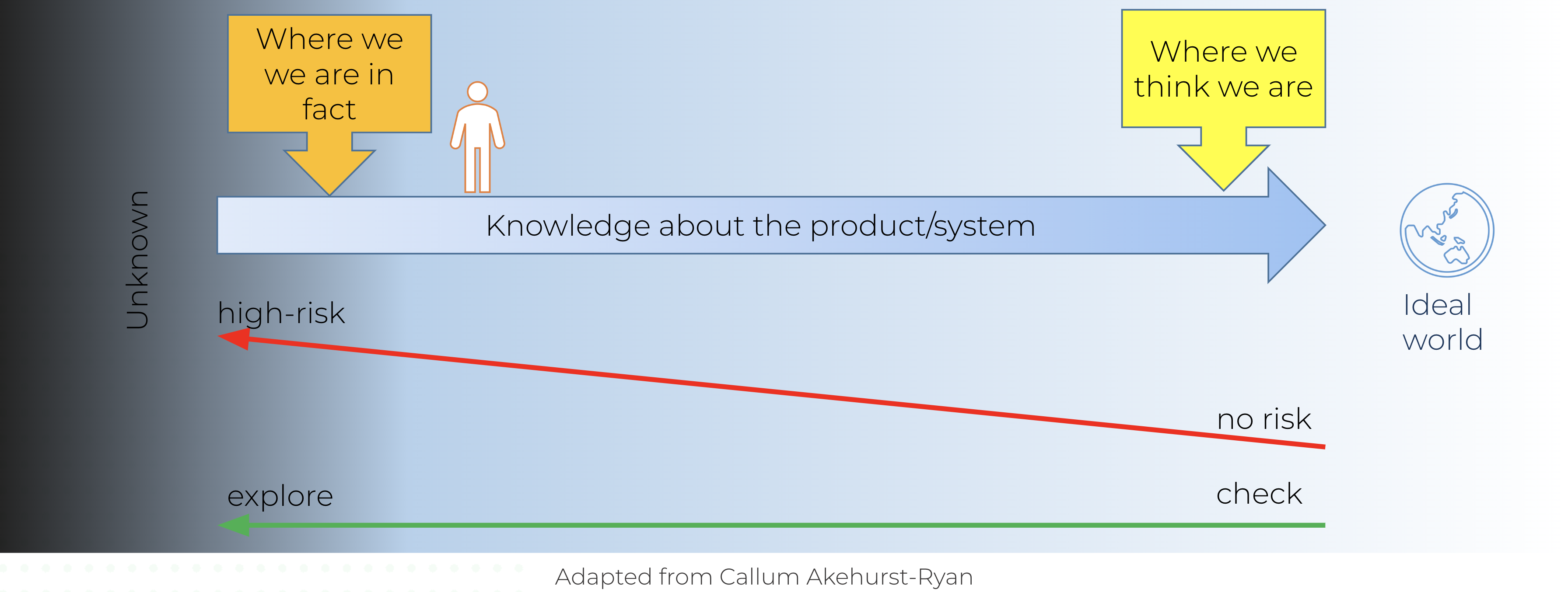Please note that the articles in this documentation feature media from app version 2.0.5. Interface elements may differ in newer versions. Refer to the latest app version for the most accurate information. |
A risk can impact (negatively or positively) the value of what we aim to provide.
Usually, we talk about risks of events that can happen with a certain probability and can negatively impact some stakeholders (e.g., users) at a certain level.
Using non-encrypted protocols can expose sensitive information, including credentials, to attackers. |
Risks can be handled differently: we can prevent/avoid them, mitigate them, or accept them.
Testing is many times seen as a risk mitigation strategy. Still, it's also a strategy for preventing risks, depending on who and when is involved while testing and the decisions that are taken upon testing findings.
We use testing to obtain quality-related information. Risks and quality have a close relationship. Risks can affect the value, as seen by some stakeholders, at a given moment. In other words, risks can impact quality. If we implement a substantial feature without listening to users or having done some preliminary research, then there's a risk of that feature not addressing the needs of our users. If we use external libraries, there's a maintenance and dependency risk that can expose us to more problems.
We use risks to drive our experiments when we test, whether implicitly or explicitly.
Potential risks are:
In sum, to consider risk:
There is no straightforward and ordered "checklist" of the risks we should tackle. That requires expertise from the tester and... context!
It's impossible to tackle all risks; it's impossible to test "everything." Therefore, whenever testing, we have to think about where we will invest our effort in so that we cover aspects that can give us valuable information about quality.
Software and the overall development process is not a localized event; its a journey. It has a past, a present, and a future.
This means that software has a history that culminates in the present...
It's important to understand...
It gives clues about:
|
It gives clues about:
|
It gives clues about:
|
Software is made to address needs. Needs can be of different types, though; they're not always "functional." What purpose are we trying to achieve, and for whom? Are there any existing references we should have in mind?
Generally, we can say that a need is met if a certain goal can be achieved effectively, efficiently, and satisfactorily.
Sometimes we focus our attention on effectiveness/correctness, leading us to look at written specifications, acceptance criteria, or claims. While correctness may be crucial for banking and financial products, it's not as relevant for a social application, where UI and UX matter most.
But needs exist not only for external users but also for internal stakeholders and even for the team supporting and developing the product. Are we using deprecated dependencies, or will dependencies have well-known security issues, for example? Can a component or a service provider easily be replaced by another one? Is our infrastructure properly tracked, is its setup scriptable, and are those scripts prone to error handling, for example?
Is testing currently just implemented at the surface? Are areas/features covered with automated test scripts? What level and type of tests (e.g., unit, integration, system, functional, performance, security)?
Knowing where we stand and depart from in testing tells us about potential risks.
What are we covering already? To what extent? Do we have quick feedback loops about it? Do we have a history of it?
The risks that we are aware of, we can handle somehow, including with more or less testing depth.
We can group risks in a matrix or in a diagram, knowledge related, to give us a better understanding of the risks that exist and how we can approach them.

Say we have selected a risk.. how can we turn it into a test charter?
Let's consider the following test charter template as a basis; remember that this a template; it's not strict, so you can adapt it freely to match your needs.
Explore <area, feature, risk> with/using <resources, restrictions, heuristics, dependencies, tools> to discover <information> |
Adapted from Maaret Pyhäjärvi, Elisabeth Hendrickson
Since we'll be performing a testing session, it will implicitly be limited in time, resources, and depth.
First, we have to consider the scope of what we aim to test broadly, i.e., the subject of our testing. Do we want to perform the testing around a specific feature? About a subset of an existing feature? Around a flow? The whole product? If the latter, you'll probably need to refine your scope and limit it further.
Second, what will we bring to the testing session? Are there any resources, tools, or heuristics that can help us? Can some restrictions be used to restrict the scope of our testing or amplify the probability of finding problems on the subject of our testing?
Third, what kind of information do we want to find? Do we want to find problems around the risk in general that we have identified? Won't that be too broad? Maybe we need to refine it.
Remember that we're talking about risks. As such, there's a probability of them occurring and the impact if they occur.
Our test charters should be around maximizing probability on one side but also consider situations with relatively low probability but still have a major impact.